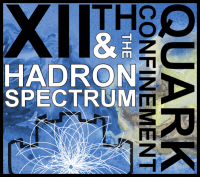Speaker
Description
A new approach to study the mass spectrum of double heavy baryons containing strange and
charmed quarks is proposed. It is based on the separation of variables in the Schrödinger equation in the prolate spheroidal coordinates. Two non-relativistic potential models are considered.
In the first model, the interaction potential of the quarks is the sum of the Coulomb and non-spherically symmetrical linear confinement potential. In the second model [1] it is assumed that the quark confinement provided by a spherically symmetric harmonic oscillator potential.
In both models the mass spectrum is calculated, and a comparison with previous results [2, 3] from other models is performed.
This work is supported by the Russian Science Foundation (grant No. 16-12-10176).
References
[1] D.U. Matrasulov, F.C. Khanna, Kh.Yu. Rakhimov and Kh.T. Butanov Spectra of baryons containing two heavy quarks, Eur. Phys. J. A 14, 81-86 (2002)
[2] Y. Namekawa et all (PACS-CS Collaboration), Charmed baryons at the physical point in 2 +1 flavor lattice QCD, Phys. Rev. D 87, 094512 (2013)
[3] Tetsuya Yoshida, Emiko Hiyama, Atsushi Hosaka, Makoto Oka, Katsunori Sadato, Spectrum of heavy baryons in the quark model, Phys. Rev. D 92, 114029 (2015)
Summary
The mass spectrum of double heavy baryons is studied in two new potential quark models based on the separation of variables in the Schrödinger equation.




